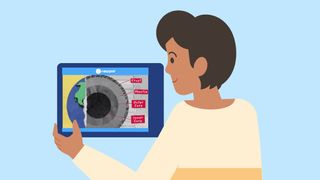The comprehensive and interactive online platform Nearpod is an all-encompassing edtech tool that can be used to carry out lesson plans for a variety of subject areas and grade levels. For an overview of Nearpod and some of the different features, check out “What is Nearpod and How Does it Work?”
Below, is a sample Upper Elementary and Lower Middle School lesson plan that is focused on a US States and Capitals Social Studies lesson.
Subject: Social Studies
Topics: U.S. States and Capitals
Grade Band: Upper Elementary and Lower Middle School
Learning Objectives:
At the end of the lesson, students will be able to:
- State the number of states within the United States of America
- Define what a state capital is
- Name at least 10 U.S. states and the respective capitals
Nearpod Creation and Instruction
To begin the lesson, you will need to create a Nearpod module. This can be done by searching within Nearpod for learning standards and objectives that match your lesson. You can either create activities adding video, text, and audio content, or by using some of the premade lessons and activities that Nearpod offers.
Start with a Quick Launch activity, using the Nearpod Collaborate Board, which is similar to a Padlet, and have students answer an open-ended question regarding what they already know about state capitals. Then, start instruction in which you introduce the different states and capitals using interactive slides within your Nearpod.
As you go through the content, have stop points for formative assessments. This can be a quick poll, quiz, or open-ended question that are all features of Nearpod that can be easily integrated. This way, you will know where students are before moving on in the lesson.
In addition to interactive slides, you can also create interactive videos or upload existing ones in which you are explaining content on the screen with dynamic images and captions.
Guided Practice and Engagement
There are many ways for students to practice and engage with content within Nearpod. For this lesson, you could include the following engagement activities:
- Have students use the matching pairs feature to match states with the respective capitals.
- Use the draw tool to write how they define a state capital, or enable the audio record feature and allow students to verbally answer.
- Place a map of the U.S. on the screen and have students use the drag-and-drop feature to place the capital in the correct state.
- List the state name and have students use the fill-in-the blanks feature to add the state capital, or vice versa.
You can also use live annotation on the screen to highlight, circle, or draw on items that you want students to focus on, and as you do, it will appear on the students’ individual devices in real-time.
Extending the Learning
After the live Nearpod lesson on states and capitals, you could have students take a Virtual Reality Field Trip through the United States, exploring some of the states and capitals that they have learned about. Through these VR technologies, students will be able to view diverse scenery and natural elements, as they travel from state to state. Nearpod has a built-in button to seamlessly add the Virtual Reality Field Trip to your Nearpod lesson that also includes mini learning activities and field notes templates to guide the experience for students.
Should I Use Nearpod for Live Instruction or Independent Work?
Both! Actually, what makes Nearpod great is the versatility in using it in three different ways.
You could:
- Have students on individual devices while teaching from the Nearpod lesson live
- Use Nearpod to show videos and engage students in the content without them having a device.
- Use it for independent student-paced personalized instruction.
What Type of Professional Learning Community Does Nearpod Offer Teachers?
Similar to the Google Certified Educator program, Nearpod offers a Certified Educator program. Community connections is a unique feature of Nearpod’s certified educator program with access to a private Facebook group and opportunity to become a school leader for Nearpod. Having other teachers to exchange ideas and build content through Nearpod can help strengthen your own lessons. As a Nearpod Certified Educator you will also receive a 6-month gold subscription, access to new features before any become widely available, and possibly some Nearpod swag.
Using Nearpod to carry out dynamic and engaging lessons in both live in person and remote online settings allows students the opportunity to deeply engage with learning content while providing them with varied opportunities to demonstrate their learning. Consider trying out Nearpod for one of your next lessons or trying a new feature of Nearpod if you have already been using it for a while.

